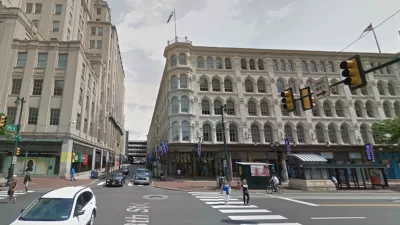An outdoor advertising company has crafted legislation, expected for City Council review, to allow electronic displays at seven locations in Center City.
Natalie Kostelni breaks the news that Thaddeus Bartowski, who runs Catalyst Outdoor, has crafted legislation that would “create a digital district in Center City that would permit electronic displays at seven locations within the boundaries of that area.”
“Called urban experiential displays, or UEDs, they would communicate advertising, news and public service announcements. These UEDs are also being proposed as a revenue generator for the city as well as a place making mechanism.”
In what’s likely a case of understatement, Kostelni writes: “The proposal has the potential to be controversial.”
Bartowski’s pitch for the signs: “What we are doing here is the convergence of art, architecture and advertising into a singular use.”
That statement prompted the following response from Philadelphia Inquirer architecture critic Inga Saffron on Twitter: “Billboard supporters will say anything.”

The proposed signage district differs from an existing signage district on East Market Street. There, digital billboards and signs must be “attached to the exterior of buildings and landlords must invest a minimum of $10 million before they are permitted put such signs on their properties,” according to Kostelni.
In the case of the proposed Center City district, “the legislation requires a minimum of $2 million investment and a company, such as Catalyst, would have to adhere to a litany of guidelines pertaining to them. A company, such as Catalyst, will have to go through the city’s planning approval process as well as the art commission before installing a display.”
The legislation has not yet been introduced to the council.
FULL STORY: EXCLUSIVE: Digital signs proposed for Center City

Alabama: Trump Terminates Settlements for Black Communities Harmed By Raw Sewage
Trump deemed the landmark civil rights agreement “illegal DEI and environmental justice policy.”

Planetizen Federal Action Tracker
A weekly monitor of how Trump’s orders and actions are impacting planners and planning in America.

Why Should We Subsidize Public Transportation?
Many public transit agencies face financial stress due to rising costs, declining fare revenue, and declining subsidies. Transit advocates must provide a strong business case for increasing public transit funding.

Understanding Road Diets
An explainer from Momentum highlights the advantages of reducing vehicle lanes in favor of more bike, transit, and pedestrian infrastructure.

New California Law Regulates Warehouse Pollution
A new law tightens building and emissions regulations for large distribution warehouses to mitigate air pollution and traffic in surrounding communities.

Phoenix Announces Opening Date for Light Rail Extension
The South Central extension will connect South Phoenix to downtown and other major hubs starting on June 7.
Urban Design for Planners 1: Software Tools
This six-course series explores essential urban design concepts using open source software and equips planners with the tools they need to participate fully in the urban design process.
Planning for Universal Design
Learn the tools for implementing Universal Design in planning regulations.
Caltrans
Smith Gee Studio
Institute for Housing and Urban Development Studies (IHS)
City of Grandview
Harvard GSD Executive Education
Toledo-Lucas County Plan Commissions
Salt Lake City
NYU Wagner Graduate School of Public Service




























